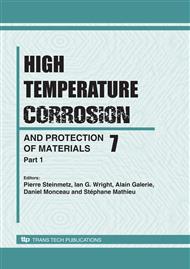p.185
p.191
p.199
p.207
p.213
p.223
p.233
p.239
p.251
Characterization of TBC Systems with NiPtAl or NiCoCrAlYTa Bond Coatings after Thermal Cycling at 1100°C: A Comparative Study of Failure Mechanisms
Abstract:
During service, TBC can suffer degradation by CMAS, FOD, erosion or spallation. Whereas the first three are due to foreign particles, the last one is related to thermal cycling. When subjected to high temperature exposures followed by rapid coolings under oxidizing conditions, a TBC system undergoes morphological changes and stress development. This will initiate cracks which propagate and finally lead to failure by spallation. Consequently, the aim of the present study is to understand better the mechanisms responsible for such spallation events. Two kinds of TBC systems with different bond coatings (NiCoCrAlYTa or Pt-modified nickel aluminide bond coatings) are thermally cycled. Subsequently, SEM investigations on TBC systems after spallation concentrate on failure path, defect, morphological and microstructural changes to propose way for improving TBC system lifetime.
Info:
Periodical:
Pages:
213-221
Citation:
Online since:
September 2008
Authors:
Price:
Сopyright:
© 2008 Trans Tech Publications Ltd. All Rights Reserved
Share:
Citation:


